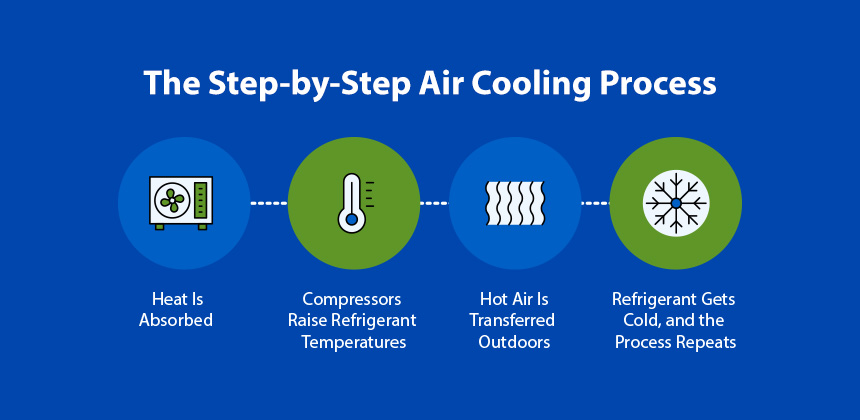
Before the invention of air conditioning in the early 1900s, people had to rely on other methods to keep their homes and buildings cool during warm days and nights. However, simply opening windows and even installing special vented levers above interior doors didn’t bring the temperature down very much.
Air conditioning was first used in more industrial and commercial settings, but it rapidly grew in popularity. People didn’t want to have to go to movie theaters and stores to get relief from the heat. They wanted to bring cool air into their homes, too. In time, they got their wish with portable air conditioners and whole-house air conditioning units.
How do air conditioners work, though? What happens inside an air conditioner that turns hot air into cool air? The process involves several key elements.
Although air conditioners can come in a variety of forms, they all rely on the use of refrigerant. A refrigerant is a gas chemical with lots of versatility. The refrigerant is located inside the air conditioning unit and remains dormant until you turn on the air conditioner or switch on your thermostat.
The step-by-step process for how AC works is as follows:

The first step of how AC units work is for the warm air in your home to be drawn through the vent. The warm air passes through filters that remove dust and particles before passing over the evaporator coil. The liquid refrigerant inside the coil converts into gas, cooling the air as it gets absorbed into the refrigerant. Your air conditioner unit comes with a fan that blows the cold air into the ducts and distributes it throughout your home.
At this point, the refrigerant is in a gaseous state. Once the air conditioner kicks in, the compressor decreases the refrigerant’s volume, which increases its temperature and prepares it for the condemning process. The condensing process allows the refrigerant to cool as it starts to evaporate.
The refrigerant reaches the outdoor condenser and makes contact with the outdoor air. The outside air absorbs the heat from your refrigerant, which helps lower its temperature and turns it back into a liquid.
Once the heat is removed from the refrigerant, the cold refrigerant travels back indoors to restart the process. The cool air is delivered into your home while the additional warm air is pumped outside. This process continues until the air conditioner receives information from sensors that your home has reached the appropriate comfort level, which has been preset based on your thermostat.
Regardless of what type of air conditioner you have, they all utilize refrigerant, which helps cool your home by removing warm air. However, different types of air conditioners may benefit your home more than others. Some common types of air conditioners include:
Regardless of the type of air conditioner you choose for your home, the cooling process generally works the same. Refrigerant is used in almost all air conditioners and helps provide an effective method for cooling, whether you need to cool your entire home or just a small room or space. During the summer, your air conditioner works to transfer the heat inside your home outdoors, helping improve the comfort of your home for your entire family.
Air conditioning systems keep the inside of your home at a comfortable temperature no matter how hot it is outside, but they offer other advantages as well:
Air conditioning may not be something that you think about every day, but it’s a lifesaver when outside temperatures rise. Getting your air conditioner checked at least once a year can help keep it running smoothly.
Looking for an HVAC partner? Shipley Energy is accepting new customers in all the locations we serve in Pennsylvania and Maryland.